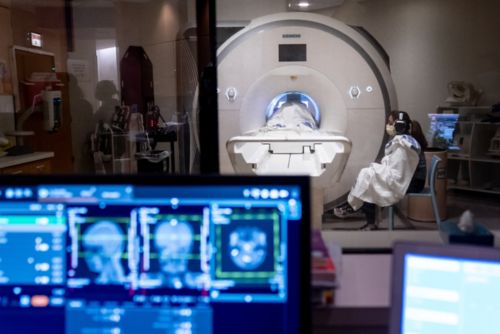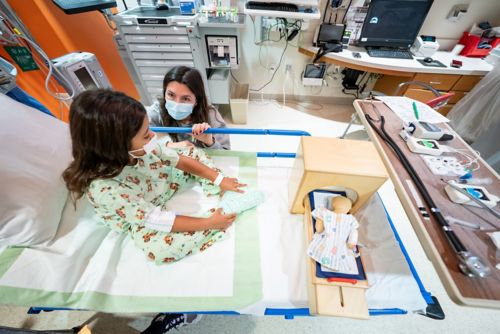Playing ‘Statue’ Can Have Big Rewards: Tips for MRIs without Anesthesia
Read this article in French, Portuguese, and Spanish.

Zari Ali completes an MRI scan without anesthesia while her mom sits nearby.
Imagine lying still as a statue for 45 minutes or more than an hour.
Now imagine doing that surrounded by what sounds like the world’s loudest washing machine or while holding your breath.
Finally, imagine doing all that when you are a kid who just learned to ride a bike.
Six-year-old Zara Ali knows all about the challenge.
At 3 years old, Zara was diagnosed with a rare brain tumor called craniopharyngioma. Her treatment included general anesthesia to help her stay in position during 30 proton beam radiation treatments. Patients must lie still so the proton beam targets the tumor and spares healthy tissue.
Three years later, Zara had finished with treatment. She needed a follow-up MRI scan so that doctors could see her response to treatment. Zara’s parents and care team encouraged her to do the MRI scan without anesthesia.
After practicing with her child life specialist, Zara was successful. She lay still as a statue for about an hour.
Concerns about anesthesia in young children
MRI scans are painless and do not involve radiation. But patients must stay still so the image is clear. That is why patients sometimes get sedation or general anesthesia.
- Sedation uses medicines that cause relaxation or sleepiness.
- General anesthesia causes a complete loss of consciousness, like a deep sleep.
Research shows that sedation and general anesthesia that is given often or lasts more than 3 hours may have a negative effect on brain development in young children.
The US Food and Drug Administration (FDA) has issued a warning on the subject. The warning focuses on non-emergency surgeries or procedures for children younger than age 3. But the FDA does not suggest delaying medically necessary surgery or procedures.
Reducing risk
Scientists are learning more about how sedation and anesthesia affect developing brains. Many hospitals are working to reduce the need for these medicines during MRI scans.
That starts with telling patients and caregivers what to expect, says Libby Gaitskill. Gaitskill is a child life specialist at St. Jude Children’s Research Hospital. She helps Zara and other patients get ready for MRIs.
“Even as adults, we cope better when we feel prepared,” Gaitskill says.
When families and clinic staff think they are ready, children can visit the mock MRI scanner and practice lying still for a scan.
“Most children start practicing at 6 or 7, but we practice with all ages. We’ve had kids about 4 and others in their teens,” Gaitskill says. “Sometimes a single practice session is enough. Others need multiple practices. We take it at whatever pace the patient and family need.”

Zara Ali and child life specialist Libby Gaitskill conduct a mock MRI scan with a doll. The session is part of a program to help young children stay still for MRI scans.
Meet the MRI
Zara giggled and played with a doll as Gaitskill told her what to expect.
The little girl had a chance to look at a mock MRI scanner. She listened to a recording of the machine’s sounds. Zara got to slide inside the mock MRI and practice lying still inside.
Then Zara slid into the real MRI machine and watched a movie. Her mom, Umber Khan, MD, sat nearby for the entire scan.
“The mock MRI helped Zara understand what would be involved,” Khan says. “We had tried to explain it to Zara, but being in the mock scanner helped a ton. When it was time for the real MRI, she just jumped inside. She was very comfortable with it.”
After almost an hour, the scans were complete. Zara emerged smiling. She celebrated with high fives for the staff. “Now that she’s done it once,” Khan says, “I think she’ll be able to do it every time.”
“Just talking about MRIs without anesthesia at home is a great way to encourage patients to try this new way of completing their imaging.”
Tips for practicing at home
Climbing into a mock MRI is not the only way to get ready for an MRI without sedation.
“For patients, the most important part is being able to hold their body in position and cope with the sounds,” Gaitskill says.
Here are tips from Gaitskill and her colleagues for caregivers to practice with patients at home.
- Talk about having an MRI scan without sedation or general anesthesia: “Talking about the process at home is a great way to encourage patients to try a new way to complete the scan,” Gaitskill says.
- Look at pictures of MRI machines: This will make it more familiar for the patients and ease their anxiety.
- Listen to what the machine sounds like: The volume will differ depending on the machine and other factors. But expect noise, including clicking sounds. Patients wear ear plugs or special headphones during the procedure. Gaitskill says being able to cope with the sound is key to patients’ success.
- Practice lying motionless: Have your child lie down and remain still. Start with 2 or 3 minutes of stillness. Gradually increase to 45 minutes. Scans sometimes take longer.
- Practice with your child how to stay still and hold their breath: Start with breathing in slowly, pause for a few seconds, and then breathe out slowly. Work up to 15 seconds between breathing in and out.
- Make practice a game: Create a small fort by placing a sheet over a small table. Have your child lie inside and use a vacuum cleaner around the ‘fort’ to simulate being in a small, noisy space.
Make sure to ask your care team questions such as:
- How long with the scan take?
- Will my child be able to watch a movie? What about listening to music or a story? Can my child have a blanket or another item for comfort during the scan?
- Can a parent or caregiver stay in the room during the scan?
- How can my child communicate with the staff?
By planning ahead, you can increase the odds of your child having a successful scan without anesthesia or sedation.





